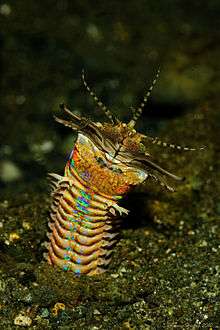Eunice aphroditois
| Eunice aphroditois | |
|---|---|
 | |
| Scientific classification | |
| Kingdom: | Animalia |
| Phylum: | Annelida |
| Class: | Polychaeta |
| Order: | Eunicida |
| Family: | Eunicidae |
| Genus: | Eunice |
| Species: | E. aphroditois |
| Binomial name | |
| Eunice aphroditois Pallas, 1788 | |
Eunice aphroditois (colloquially known as the Bobbit(t) worm) is an aquatic predatory polychaete worm dwelling at the ocean floor. An ambush predator, the animal buries its long body into an ocean bed composed of gravel, mud, or corals, where it waits for a stimulus to one of its five antennae, attacking when it senses prey. Armed with sharp teeth, it is known to attack with such speed that its prey is sometimes sliced in half.[1]
Eunicids inject a toxin into their prey, which stuns or kills it, such that prey much larger than the worm itself can be eaten and digested.[2] Another family of polychaete worms, the fireworms (Amphinomidae), have harpoon-shaped chaetae (bristles) that release a toxin that can cause severe skin irritation, but in E. aphroditois, the chaetae are used only for grip when crawling over sediment.[2]
Little is known about the sexual habits and lifespan of this worm, but researchers hypothesize that sexual reproduction starts at an early stage, maybe even when the worm is about 100 mm (4 in) in length; this is very early, considering these worms can grow to sizes of nearly 3 m (10 ft) in some cases (although most observations point to a much lower average length of 1 m (3 ft 3 in) and an average of 25 mm (1 in) in diameter).
E. aphroditois is found in warmer oceans around the world, including the Indo-Pacific and Atlantic.[3]
In aquaria
Bobbit worms may be accidentally introduced into artificial environments.[4] In March 2009, the Blue Reef Aquarium in Newquay, Cornwall, discovered a Bobbit worm in one of their tanks. The workers had seen the devastation caused by the worm, such as fish being injured or disappearing and coral being sliced in half, but did not find it until they started taking the display apart in the tank. The worm was nicknamed "Barry".[5]
Another Bobbit worm, 1.1 m (3 1⁄2 ft) long and several centimetres thick, was found October 7, 2013 in Maidenhead Aquatics in Woking, Surrey.[6]
Name
The name "Bobbit worm" was coined in the 1996 book Coral Reef Animals of the Indo-Pacific, in reference to Lorena Bobbitt,[7] who was then very much in the public consciousness. The name is inspired only by the scissorlike jaws of the worm; the common supposition from the name that female eunicids cut off the males' penises is baseless, and the worms in fact lack penises entirely, as they are broadcast spawners.
References
- ↑ Crew, Becky (October 22, 2012). "Eunice aphroditois is rainbow, terrifying". Scientific American. Retrieved 2013-03-13.
- 1 2 Simon, Matt (September 6, 2013). "Absurd Creature of the Week: 10-Foot Bobbit Worm Is the Ocean's Most Disturbing Predator - Wired Science". Wired.com. Retrieved 2013-09-09.
- ↑ SeaLifeBase (19 July 2012). Eunice aphroditois. Retrieved 3 June 2013.
- ↑ Schulze, Anja (December 2011). "The Bobbit Worm Dilemma: A Case for DNA". Revista de Biología Tropical. 59 (4): 1463–1474. doi:10.15517/rbt.v59i4.3412. Retrieved 7 September 2013.
- ↑ "Barry the giant sea worm discovered by aquarium staff after mysterious attacks on coral reef". Daily Mail. London. 2009-03-31.
- ↑ "Secret giant worm behind mystery of vanishing aquarium fish". The Telegraph. 18 October 2013. Retrieved 24 October 2013.
- ↑ "Who Named the Bobbit Worm (Eunice sp.)? And WHAT species is it.. truly??". 2014-08-13.
External links
| Wikimedia Commons has media related to Eunice aphroditois. |
- Keith Davey (2000). "Eunice aphroditois". Life on Australian Seashores. Retrieved 2007-10-10.
- Bannister, JV; Bannister, WH; Anastasi, A (1976). "Isolation, characterization and oxygen equilibrium of an extracellular haemoglobin from Eunice aphroditois (Passas)". The Biochemical Journal. 159 (1): 35–42. doi:10.1042/bj1590035. PMC 1164035
 . PMID 11776.
. PMID 11776. - Fauchald, Kristian (1992). "Eunice aphroditois (Pallas, 1788)". A Review of the Genus Eunice (Polychaeta: Eunicidae) Based upon Type Material. Smithsonian Contributions to Zoology. Smithsonian Institution Press. pp. 62–4. doi:10.5479/si.00810282.523. hdl:10088/6302.
- Image of the worm.
- More images of the worm.
- Scott Gietler. "The Bobbit worm, Eunice aphroditois". Underwater Photography Guide. Retrieved 2013-10-14.